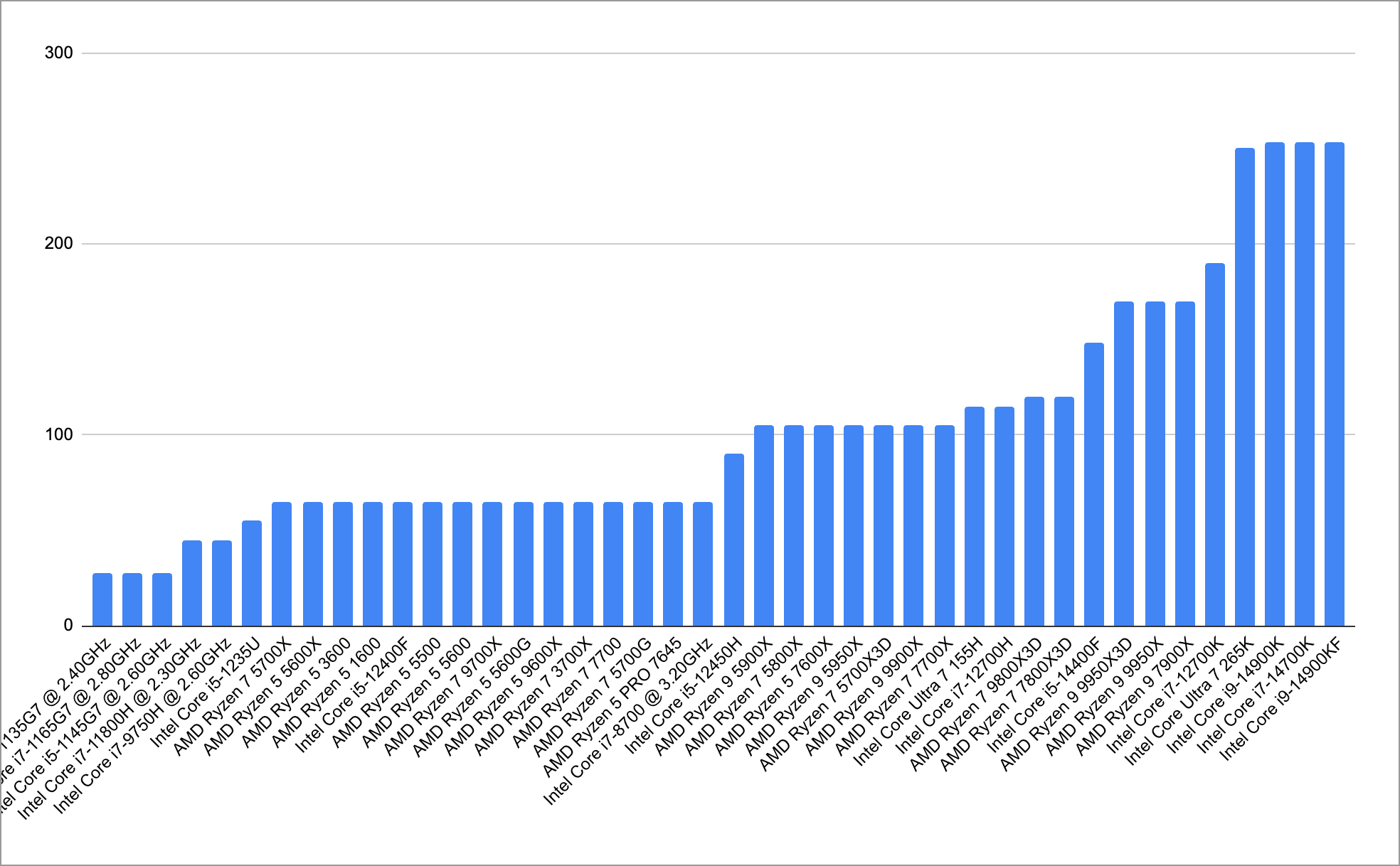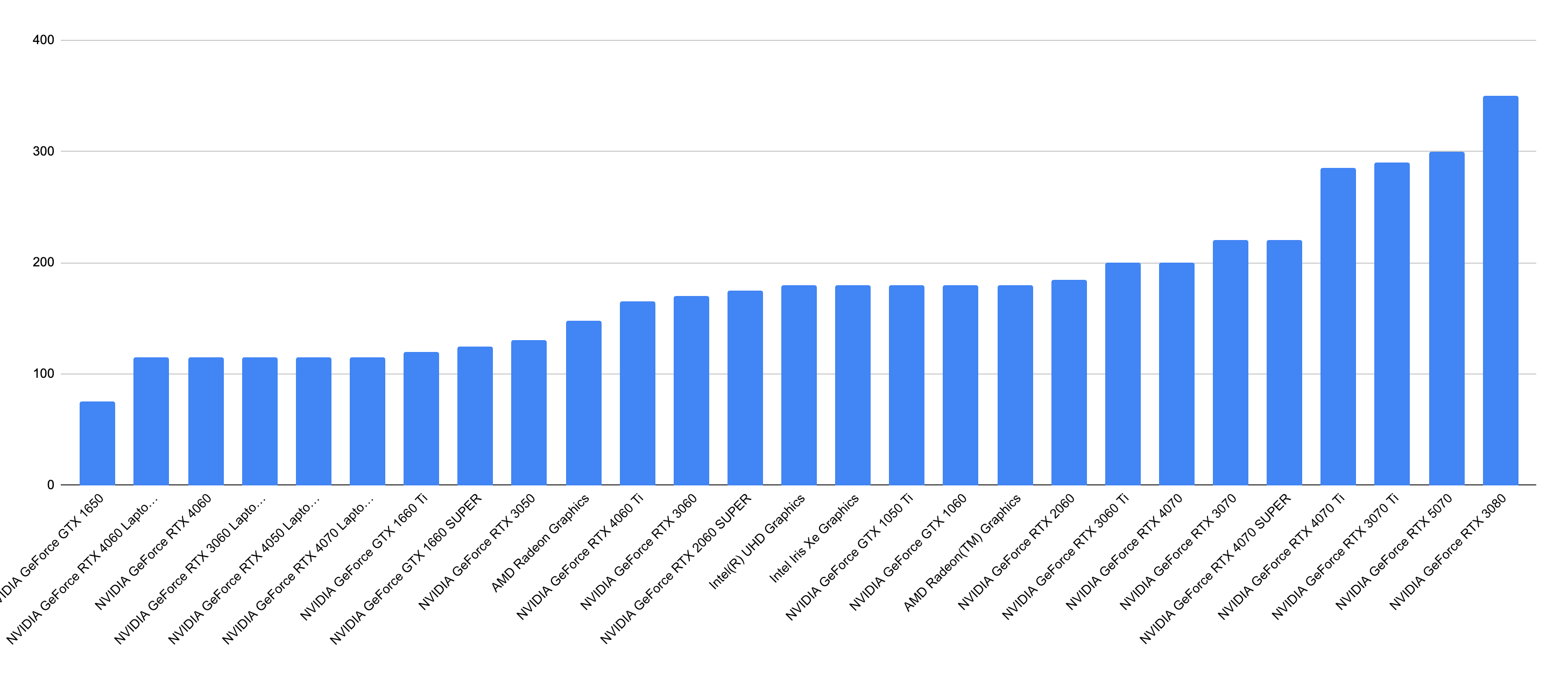How big a problem are PC gaming emissions?

One of the assumptions I have seen over the past couple of years is that “PC gaming emissions are so much higher than console” – which has not been helped, I think, by the eye-watering power consumption of high-end Nvidia 5000 series GPUs, which I wrote about back in January. In that post, I simply looked at the energy consumption of GPUs represented in the Steam Hardware survey, using a quite crude assumption of each GPU being used for an hour a day. Without more granular data, it was hard to know how realistic this was.
Recently, I came across the highly useful Steam Charts website, and in particular, its dataset of Top games on Steam ranked by hours played. It describes how it collects this data as follows, which is quite brilliant in its simplicity: “The collector queries the number of concurrent players on an hourly interval for every single game in the Steam catalog, and has been collecting data since July of 2012.” Given the scale of Steam and its population (36m at peak times), querying the number of players every hour and averaging that number out to be the "hours played" over a period is probably a reasonably good way of sampling a huge dataset in as close to real time as we can get. So I'm treating Steam Charts as a “good enough” data source for representing the overall hourly player-hours trends, especially for the most played games, which have hundreds of thousands (even millions) of players at any given time, and the overall trend is the most important thing. Players are logging on and logging off from these games constantly, so it probably all comes out in the wash. I imagine it's less accurate for the long tail of games that people play for short stretches or that almost no one ever plays (more on that in a moment).
The other piece of the puzzle is what sort of power consumption profile we should expect for all these players. For that, I want to introduce you to the SGA PC gaming hardware power profile. It’s part of one of our methodologies for calculating PC gaming end-user emissions, based on the Steam hardware survey.
To produce a power profile of the Steam user base for use in the Standard, I built a small database of CPUs and GPUs, as these are usually the two main power-consuming components of the ordinary desktop PC. I limited it to just the most popular components – CPUs that were >0.5% of the survey, and GPUs that were >1%. That gave us 42 different CPUs, and 27 GPUs, which I then went and hunted down TDP values for. TDP stands for thermal design power, so it’s not an exact 1:1 for power consumption, but it’s pretty close, and gives us a reasonable estimate. Though adding some extra complexity, AMD doesn’t use TDP but TBP (total board power), which is closer to the whole power usage of the card, and some products give a “range” rather than a single (maximum, I assume) value... It's a bit of a mess, but it’s as good as we’re going to get.
Then, I graphed the TDP/TBPs of each of these devices and bucketed them into low/medium/high spec, with some breakpoints that seemed to make sense to me.
Here’s the CPU TDP chart (sorted by power consumption – the left axis is Watts):

Lots of 65 Watt CPUs (about 15% of the Steam sample), some 120-Watt CPUs (about 8%), and then the remainder up to 250 Watts (making up just 5% of the Steam survey).
And here’s the GPUs (also sorted by power consumption, also Watts vertically):

One of the main things to note here is just how few 50xx series cards appear (this data is from July 2025, FYI). This will change over time, but so far these new power-hungry (and expensive) cards aren’t really being bought in enough numbers to cross the 1% threshold. The one exception is the 5070, and it had only just made it in July. We aim to repeat this process and update the numbers semi-regularly – perhaps every 6-12 months, to reflect what’s actually in use out and have the most accurate numbers.
Lastly, I added the CPU and GPU figures together and added a small amount of extra overhead – about 10% – for the other system components, like RAM, the motherboard, storage, etc. The key concern for our purposes now is how popular each particular bucket of low/medium/high spec device is.
I tried to get the interactive version of this chart of GPU power consumption and popularity on Steam to work here, but it refused to keep the x-axis scale setting and was basically unintelligible, so here's the static version – click through to see the spreadsheet and the interactive chart if you like.

We’re concerned with reading clusters of power consumption up the vertical axis. To my eyes, there’s a sort of cluster of GPUs around 150 watts, another cluster around 180 (plus or minus 10-20 watts), and then a small number of very high power cards. Note how all the high power cards are very low percentage.
Combining those GPU clusters with the CPU power splits, I reached the following approximate hardware profile for the different percentages of the Steam user base gaming on low/medium/high spec devices:

Low spec is about 260 Watts – or a bit more than a PS5. That's the bulk of players. The next is a medium spec, about a third of all Steam users, at 343 Watts. That's higher than any current console. And finally, the high-spec is 566 Watts at just 14% of all players. This is just an approximation, and I wanted it to be a conservative model, so that we risk overestimating slightly rather than underestimating.
But we now have an approximation of the Steam user base and the hardware energy consumption we can expect. We can now combine this with the Steam charts data to get a sense of how long all this hardware is (probably!) powered on for and consuming energy.
Initially, I just manually copy+pasted hours played totals from Steam Charts Top 50 titles by hand. But then I had the idea to ask a good friend if he could help me figure out how to scrape the whole dataset. So thank you very much Nik, for writing me a little Python script to automate the process, as now I (and you!) have access to hours played data for all 12,698 Steam games that Steam Charts has data for from the last 30 days (as at 17th Nov 2025).
There are several interesting insights we get from this. First, the hours played by players of just the top 50 games on Steam represented 55% of all hours played as measured by Steam Charts. That’s a lot of concentration among top titles, which I think will come as no surprise to anyone familiar with the current state of the industry. Next, the top 500 games represented 88% of all hours played on Steam for the past 30 days, according to Steam Charts. That means the remaining 12,000 games on Steam attracted just 12% of all PC playtime. 🥲
So let's run the power consumption numbers using the hardware profile over those figures, and then apply a global average emissions factor (473.13 gCO2e/kWh). When we do that, it gives us the following results:

TL;DR – All of Steam players over the past 30 days played for about 5.5 billion hours and consumed (in my estimation) around 1.85 Terrawatt hours of electricity. That amount of power may have emitted as much as 876,000 tCO2e. If we multiply that by 12 to give us an annual estimate, that’s 10.5 million tCO2e per annum from Steam games.
What does 10.5 million tCO2e look like? It’s the same as 2.4 million cars driven for a year, or 2.1 million US homes’ electricity consumption for a year. In terms of energy generation, it’s 2.8 coal-fired power plants, or three thousand wind turbines for a year. In terms of the number of trees planted, it’s 173 million seedlings grown for a decade (just in case you were still labouring under the misapprehension that we could simply treeplant our way out of the climate crisis).
But we can also compare it to similar other sections of the games industry – in Sony’s most recent annual GHG disclosures, PlayStation users in 2024 emitted 5.96 million tCO2 – that's not all that far behind Steam.

So, how big a problem is PC gaming's energy usage and emissions? A pretty big one, that is now clear – but it’s also not the exclusive problem. It's not an order of magnitude bigger than console gaming, for instance. Yes, it’s one part of the challenge, just like consoles and mobiles, and even the development and distribution processes of games themselves. The main problem I see is that there’s no one really trying to organise or advocate in this section of the industry, at least not yet, and I think that's something the SGA and our members are uniquely positioned to do. Unlike a Sony or a Microsoft, who each has a certain level of corporate responsibility for the gaming devices they make, there are hundreds, if not thousands, of PC hardware vendors, and probably tens of thousands of PC game developers. Few, if any, have a credible sustainability strategy or a visible and active net-zero program (though please alert me if I have missed any). It is going to take a whole network of companies and people and projects, researchers and developers to make a real dent in the PC gaming footprint.
Eagled-eyed chart readers might have spotted the final column in the summary table earlier, which has a potential “total annual eco mode savings”. This is my best estimate of how much greenhouse gas emissions we could save on PC if every Steam game came with an embedded eco mode. It’s about 9% of the total, or 757k tCO2e per annum, and based on the Epic whitepaper about their experience with an Eco mode for Fortnite and the Xbox Series X console. It might not translate exactly the same to PC, but I think it’s probably pretty close. It might even be higher due to the higher power profile of PCs.
There’s also some encouraging evidence that this process might be starting – take a look at this screenshot from Embark Studios' smash hit ARC Raiders (which I’ve been enjoying immensely). At the bottom of the menu is an “Idle Energy Saving” mode. How cool is that?

Unfortunately, at present, I think it’s either implemented its settings at too high a level to make a difference for all but a very small portion of players with super high-end PCs, or it's not working as expected. In my testing and over about 60 hours of play, I have not once come back to a menu screen in a visible eco mode state, with the Steam FPS counter never dipping below 59 after long stretches of idling. Here’s two screenshots of the game on menu screens from about 5 minutes of dedicated idling in menus, neither seemed to have low FPS (according to the Steam FPS counter – not captured in the screenshots, you'll just have to trust me), and it's the same basically anytime I'm on a menu screen whether I'm active or not. I know that the render resolution scaling is meant to be dynamic and almost imperceptible, but I would expect at least some change if it's working and I haven't seen any.


I couldn’t see any sort of visual change or FPS limit even after five minutes. Perhaps the settings need dialing back? Epic and most other eco mode studies suggest a 30FPS cap for idle, and resolution to scale to 50-60% of max. Maybe the DLSS settings are interfering? Whatever the case is, if anyone has a contact at Embark who could pass this along and get them to look into it, I’d appreciate it. I want to save money on my power bill! Doesn't everyone? This is just preventing wasted power while I'm AFK.
In any case, I'm encouraged by a big new title attempting an Eco Mode in a PC release without, seemingly, having to be told or asked to implement it (as far as I know – I could be wrong, of course). If that's the case, it's exactly what we are going to need to see more of, if we are to realise that 700k tonnes lopped off the 10.5 million tCO2e figure.
There are some remaining uncertainties to these estimates, naturally. For one, it’s unclear that the entire Steam survey matches the hardware profile of all of the most active players, or even of all the most played games. For example, Battlefield 6 is one of the top 10 games on Steam by hours played, and its minimum required GPU is a 3060Ti, which draws 200 watts. There are some lower–power, higher-performing cards in the 4000 series than the 3060Ti (for e.g. the 4060), but only a couple. So I suspect the player base of BF6 is unlikely to be on “low spec” PCs in the same ratio as the wider Steam player base. I suspect the overall effect of accounting for minimum specs of specific games would be to skew the numbers higher in most cases.
Additionally, as part of the SGA Scope 3 Standard, we built into our Scope 3.11 PC gameplay part of the Standard a method that uses this “minimum system specs” approach to estimate a “baseline” energy and emissions profile for a game and its playerbase. This is the approach pioneered by the JYROS calculator and first suggested (I believe) by Pierre Forest (hi Pierre if you're reading!), and is another datapoint to approach the question from – I would love to see some developers taking this approach to their games. Unfortunately, it’s not quite as applicable to the entire Steam library as it's quite labour-intensive to gather all the minimum system specs information for 12,000+ games.
And finally, there's some more uncertainty based on not knowing where these players are playing from. It would be great if Steam provided geo information about where these players are, as without this, we have to resort to using a single global average emissions factor. If most players of a game are in Europe, for example, then the emissions from their energy consumption will be quite different to their players who are based in North America, Asia or the Middle East. Steam could do a lot of really simple, really powerful automation and embed some of these aspects of the SGA Standard into the platform to make these sorts of calculations accessible for developers. But I suspect we need to demonstrate sufficient demand for it first before Valve is likely to be willing to devote the time and resources to it. That means we need to make the network of developers and game industry companies that are part of the Sustainable Games Alliance as big and as broad as possible – so please consider joining. We have so much potential we can do, but only if we get on board.
If you are interested in double-checking any of my maths or doing your own estimates, take a look at either the SGA S3.11 PC data input sheet, which has the entire CPU and GPU database in it, or the Steam Charts data, which I’ve run the Steam Hardware model across to generate these estimates of energy consumption and emissions. If you do, let me know how you go, and what you find out, especially if you want to use it for your own players and your own games. There’s literally millions of tonnes of CO2 to save.
Thanks for reading GTG! It's always a thrill to get to sit down and work out these figures and estimates and share them with you. So much of my ability to do that is enabled by the contributions of a small but elite group of GTG Supporters – so thank you, GTG Supporters!
If you want to join this crack team of sustainability-supporting super-legends, it's only a few bucks a month, or an annual amount that is probably less than the last Triple-A game you bought. Just a thought!